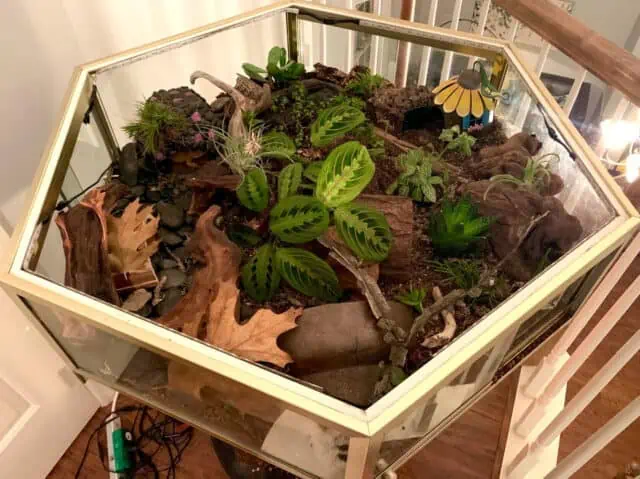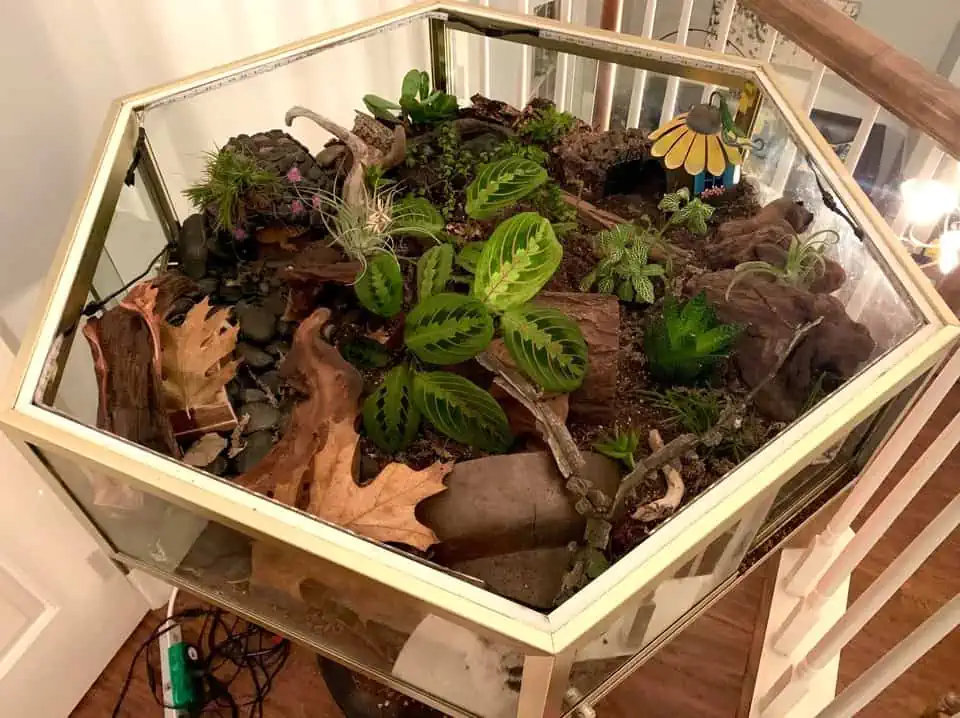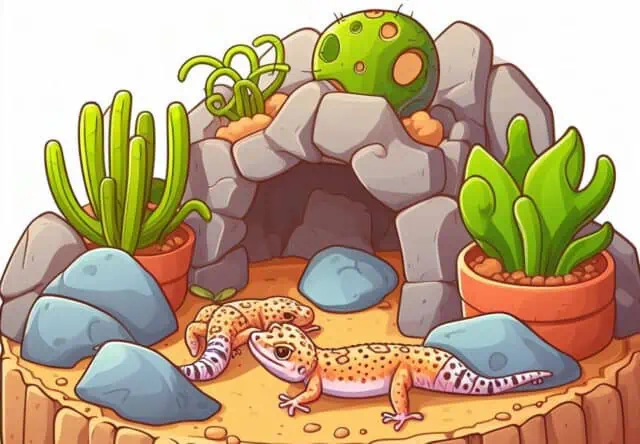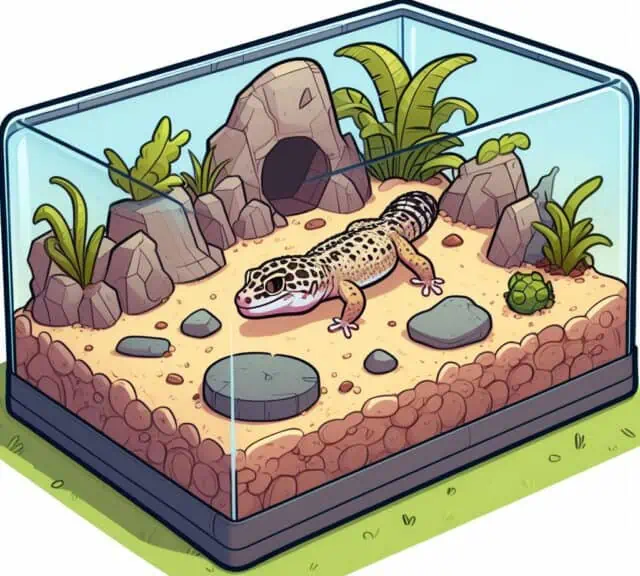A Leopard Gecko vivarium is a specially designed enclosure for these unique reptiles. Think of it as their own mini-world. In simple terms, a vivarium is a contained space that replicates the natural environment of an organism. For our Leopard Gecko friends, it’s like giving them a slice of their home turf, right inside your living room.
But, why a vivarium? First, it keeps the gecko safe. It shields them from any household dangers. More than that, it helps control factors like temperature, humidity, and light. These are crucial for a gecko’s health.
With a vivarium, you’re not just giving them a place to live; you’re ensuring they thrive. Benefits? Plenty. You get a happy gecko, a neat display for your room, and a closer connection with nature. It’s a win-win!
Vivarium Size: Ensure baby leopard geckos start in a container around 10 x 8 x 6 inches. Adult geckos need larger tanks, approximately 86 x 37.5 x 42cm.
Temperature Control: The ideal temperature varies across the tank. Generally, maintain the warm end at about 88°F-92°F (31°C-33°C) and the cooler end around 75°F-80°F (24°C-27°C). Utilize heated ceramic emitters or heated rocks for consistent heat.
Humidity Balance: Aim for ideal humidity levels between 30% to 40%. Use a hygrometer to monitor, and adjust using water dishes or misting.
Lighting: Leopard geckos are nocturnal. Ensure a dark environment at night, but offer a basking lamp during the day to replicate their natural light cycle.
Substrate: Avoid sandy substrates which risk impaction. Opt for safer choices like stone slate or paper towels. Consider the benefits and drawbacks of each material.
Leopard Gecko Vivarium: Important to Know

When diving into the world of reptile keeping, understanding the essentials of a leopard gecko vivarium is paramount. This isn’t just any habitat; it’s a tailored space designed to meet the specific needs of a leopard gecko. Let’s break this down.
The tank material plays a significant role. Glass is a popular choice as it offers great visibility and retains heat effectively. This allows your gecko to bask comfortably, and for you, a clear view of your little friend’s activities.
Next, we have the heat source. Leopard geckos, being cold-blooded, rely on external sources to regulate their body temperature. Under-tank heaters or heat lamps can be employed to maintain the right temperature gradient. This ensures your gecko can move between warmer and cooler areas as needed.
Then there’s lighting. Contrary to some beliefs, these creatures require a day-night light cycle, much like we do. Proper lighting not only replicates their natural habitat but also aids in regulating their internal biological clocks.
Humidity is another vital factor. Leopard geckos hail from arid regions, meaning they prefer a drier environment. However, a slight humidity boost can assist in shedding processes. Maintaining the right balance is key; too much moisture can lead to fungal and bacterial issues.
Finally, the substrate acts as the flooring of the vivarium. This can range from newspaper to reptile carpet or even stone slates. The right substrate keeps the gecko comfortable, assists in maintaining temperature, and reduces the risk of impaction, a common health concern for geckos.
Setting Up a Vivarium For a Leopard Gecko
Setting up a vivarium for a leopard gecko is more than just assembling a tank. It requires careful consideration of their natural habitat and needs.
What Size Should A Vivarium Be For a Leopard Gecko?
When setting up a leopard gecko vivarium, size matters. Much like our own homes, space needs vary with growth and age. For the tiny baby leopard geckos, starting off in small containers measuring approximately 10 x 8 x 6 inches works best. It gives them a snug space, reduces stress, and ensures easier access to food.
But, as they grow, their needs change. Adult geckos demand more space to roam, stretch, and hunt. Thus, transitioning to larger tanks, specifically around 86 x 37.5 x 42cm, becomes necessary. This ample space allows for better heat gradient establishment, offering both warm and cool retreats.
Now, a few things to keep in mind. Leopard geckos, being ground-dwellers, require tanks that are wider rather than taller. Height isn’t a priority, but the width sure is. Additionally, including a screen lid is not just an option but a necessity. It aids in ventilation and prevents any unexpected escapes or potential threats from entering.
What’s The Right Temperature And How To Keep It At That Level?
Achieving the ideal temperature in a leopard gecko vivarium is akin to setting the right ambiance in our own homes. Just as we require a comfortable living environment, so do our scaled friends. For leopard geckos, the vivarium should maintain a temperature gradient between 75°F on the cooler end to about 90°F on the warmer end. This gradient allows the gecko to regulate its body temperature by moving between the cooler and warmer sections as needed.
Understanding and maintaining temperature regulation is crucial for the gecko’s well-being. In the wild, these reptiles move between sun and shade to regulate their body temperature. In captivity, we replicate this natural behavior by creating temperature zones. There are three areas in the tank that require our attention: the warm side, the cool side, and the moist hide. The warm side should be between 88°F and 90°F, the cool side between 75°F and 80°F, and the moist hide should remain at a constant mid-80s°F.
To achieve this ideal setup, there are multiple heating tools available. Heated ceramic emitters are an excellent choice, emitting heat without producing light—perfect for nocturnal creatures like the leopard gecko. Another option is heated rocks, which, when used correctly, can provide a warm spot for your gecko to lounge on. However, it’s essential to monitor the temperature of these rocks to prevent any potential burns.
Humidity Requirements For the Leopard Gecko
In a leopard gecko vivarium, maintaining the right humidity is just as essential as ensuring the correct temperature. Proper humidity requirements cater to the health and comfort of these beautiful reptiles. For leopard geckos, the ideal humidity levels sit between 30% to 40%. It’s a delicate balance; too low, and the gecko can suffer from shedding issues; too high, and you risk respiratory problems or bacterial infections.
The potential risks of incorrect humidity can’t be overlooked. While shedding, a leopard gecko needs a slightly increased humidity to help it remove its old skin properly. However, a consistently high humidity environment can be a breeding ground for harmful bacteria, potentially leading to skin and respiratory infections.
Monitoring humidity is a straightforward task with the right tools. Every owner should invest in a reliable hygrometer, a device that measures the amount of moisture in the air. With this instrument, you’ll be able to keep a close eye on the vivarium’s internal conditions.
But what if you need to make adjustments? One simple method involves adjusting the humidity by changing the size of the water dish. A larger dish will increase evaporation, thereby raising the humidity, while a smaller dish will do the opposite. For a temporary humidity boost, especially during shedding, consider adding a moist hide filled with damp moss.
Lighting: What Type and the Day/Night Cycle
Proper lighting in a leopard gecko vivarium is paramount, not only for visual aesthetics but, more importantly, for the well-being of your reptile friend. Leopard geckos are fascinating creatures with distinct lighting requirements, closely tied to their natural habitats and behaviors.
First and foremost, understanding the day/night cycle is crucial. In the wild, leopard geckos are nocturnal creatures. This means they’re most active during the nighttime, resting and hiding away during the daylight hours. As a result, they require a dark environment at night. Avoid bright lights during these hours, as it can disrupt their natural behaviors and stress the animal.
During the day, while you don’t need specialized UVB lighting as you might for other reptiles, providing a basking lamp can be beneficial. This offers a warm spot in their enclosure, mimicking the warmth of the sun. The light cycle should ideally mirror a typical 12-hour day to help establish and maintain the gecko’s regular day and night routines.
Suitable Substrate and Bedding Options
The foundation of a leopard gecko’s home is the substrate. Much more than just the floor of their vivarium, it impacts their well-being and day-to-day activities. It’s crucial to choose suitable substrate options to ensure your gecko’s health and safety.
Selecting the wrong substrate can lead to serious problems. For instance, while sand might seem like a natural choice, it poses significant risks. When ingested, sand can lead to impaction, a potentially fatal blockage in the digestive tract. So, preventing impaction is of the utmost importance, and it starts with choosing the right bedding.
Here are some recommended substrates and their benefits and drawbacks:
Stone Slate:
- Benefits: Non-porous, easy to clean, and retains heat well.
- Drawbacks: Can be heavy, and edges might need to be smoothed to prevent injury.
Paper Towels:
- Benefits: Cheap, absorbent, and simple to replace. They also make monitoring gecko’s droppings easier, which is crucial for health checks.
- Drawbacks: Not the most visually appealing and doesn’t offer a natural look.
Decorating a Vivarium
The appearance and functionality of a leopard gecko’s home play a vital role in its well-being. Decorating a vivarium isn’t just about aesthetics; it’s about creating an environment where your gecko feels safe, stimulated, and comfortable.
There are plenty of options when it comes to vivarium decorations:
Hiding Spots: Crucial for any vivarium. They provide a sanctuary where geckos can retreat and feel secure. Both full and partial hiding spots are beneficial. While full hiding spots offer complete seclusion, partial spots allow them to observe their surroundings without being entirely exposed.
Warm End Decorations: These decorations are positioned at the warmer end of the vivarium. They can include resin ornaments, which are easy to clean and move around. Additionally, natural rocks and slate pieces can be used, as they absorb and retain heat, creating a warm surface for the gecko.
Hardwood Pieces, Flat Cork Pieces, and Resin Caves: These elements add a touch of naturalism to the vivarium. They also serve as both decorative and functional items, providing climbing surfaces and additional hiding spots.
Water Bowl: A critical component. Geckos need access to fresh water. The bowl should be deep enough to hold water but not so deep that the gecko could find it challenging to climb out. This ensures that the water doesn’t evaporate too quickly, and your gecko remains hydrated and safe.
Where To Place a Leopard Gecko Vivarium?
Choosing the perfect spot for a leopard gecko vivarium is a decision influenced by various factors. Placing the vivarium in an appropriate location is essential, not only for your gecko’s well-being but also for practical reasons such as maintenance and daily care.
It’s essential to position the vivarium where you can access it effortlessly. This ensures that routine tasks like feeding, cleaning, or checking the water and humidity levels are hassle-free. If it’s difficult to reach or maneuver around, there’s a risk of neglecting these crucial aspects of care.
Proper ventilation is vital to prevent mold growth and ensure a healthy environment inside the tank. Hence, the vivarium should be located in an area where fresh air circulates freely, without direct drafts. Avoid placing it in confined, stuffy areas.
Leopard geckos aren’t particularly large reptiles, but their tanks can be, especially as you incorporate all the essential elements like hiding spots, basking areas, and decorations. Before deciding on a location, measure the space and ensure it comfortably accommodates the tank’s dimensions. Also, anticipate potential growth or upgrades in the vivarium size.
While it’s not a direct factor linked to the mentioned keywords, it’s worth noting that placing the tank in quieter areas, away from constant movement or noise, helps reduce stress for the gecko. They’re more likely to come out, explore, and exhibit natural behaviors when they feel secure.
Vivarium vs Bioactive Setup: What’s The Difference?
When it comes to housing leopard geckos, two primary setups emerge: the vivarium and the bioactive setup. Both have their merits, but they differ considerably in their approach and components.
Vivarium: The term “vivarium” denotes an enclosed space, such as a tank or terrarium, created to keep and raise animals for observation, research, or as pets. In the context of leopard geckos, a vivarium usually consists of artificial elements like plastic or resin hides, faux plants, and non-living substrates. The environment, while tailored to meet the gecko’s basic needs, does not necessarily replicate its natural habitat. Regular cleaning is required, as waste isn’t broken down naturally.
Bioactive Setup: A step closer to nature, a bioactive setup aims to mimic the natural environment of the animal as closely as possible. For leopard geckos, this would mean creating a desert-like ecosystem within the enclosure. This setup incorporates live plants, organic substrates, and microfauna like beneficial bacteria, fungi, and tiny invertebrates. These organisms work together to break down waste, promoting a self-sustaining ecosystem within the enclosure. The goal is to allow natural processes to maintain the environment, reducing the frequency of manual clean-ups and offering the gecko a more authentic habitat experience.







